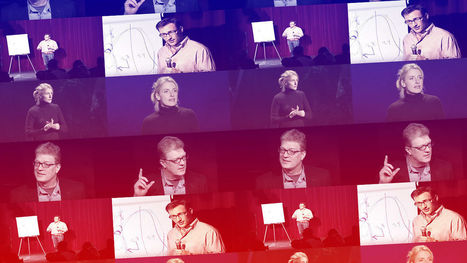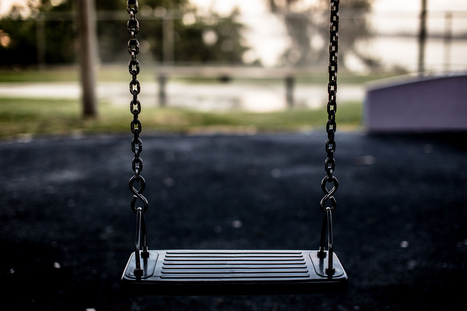Here's a list/rant about all the crappy advice I've heard from "presentation gurus" over th
Get Started for FREE
Sign up with Facebook Sign up with X
I don't have a Facebook or a X account
 Your new post is loading... Your new post is loading...
 Your new post is loading... Your new post is loading...

Randy Bauer's curator insight,
March 11, 2016 2:37 PM
What a great post! Yes, yes, yes -- adding dialogue to any story, talk, or presentation you give adds to its engagement, memorability, and power.
The 3 ways offered here really work and I use them all the time, depending on the story and the situation.
Try just one of these and experience the difference it makes. Play with all three. You'll be glad you did.
This review was written by Karen Dietz for her curated content on business storytelling at www.scoop.it/t/just-story-it. Follow her on Twitter @kdietz

The Learning Factor's curator insight,
November 19, 2015 8:35 PM
Hand talkers have a leg up with these public speaking tricks.

massimo scalzo's curator insight,
July 27, 2014 8:34 AM
Thank You Karen ! It's very very interesting !!! 
Alain Theriault MBA's curator insight,
July 29, 2014 12:22 PM
the more information overload out there, the more it becomes important to be able to tell a memorable story! 
Martin (Marty) Smith's curator insight,
August 6, 2014 4:09 PM
Funny was just thinking about how everything starts with a story now. Didn't think about these five "mistakes" though. Great post. |

Katie Anderson's curator insight,
March 1, 2016 8:32 AM
Every time I'm getting a story ready to tell, or every time I give a storied talk, I storyboard my presentation on a set of 3x5 cards (1 image/trigger word per card), than go for a walk. Why? Because it embeds the story into my body and becomes much more of a whole brain/body experience. That way it's a lot easier to tell when I'm on the stage. Or if I know I have a talk coming up, but I'm not sure about what I'm going to say, I go on a walk. Presto magic, while on the walk I figure it all out. This is when I take my cell phone with me that's got the Evernote app on it. I open up a new note in Evernote and can record my thoughts and the talk right into the note while walking. By the time I get back to the office, my thoughts/outline/story are already on my computer waiting for storyboarding and polishing. Easy peasy! Now researchers at Stanford Univ. have confirmed how powerful walking is in stimulating creativity. Since storytelling is a creative act, it's no wonder how walking can work so well with them. You'll enjoy this post, along with the 13:45 minute interview with Mary Oppezzo, one of the 2 Stanford walking researchers featured. Story on! This review was written by Karen Dietz for her curated content on business storytelling at www.scoop.it/t/just-story-it. Follow her on Twitter @kdietz 
Kevin Watson's curator insight,
March 7, 2016 7:20 AM
Every time I'm getting a story ready to tell, or every time I give a storied talk, I storyboard my presentation on a set of 3x5 cards (1 image/trigger word per card), than go for a walk. Why? Because it embeds the story into my body and becomes much more of a whole brain/body experience. That way it's a lot easier to tell when I'm on the stage. Or if I know I have a talk coming up, but I'm not sure about what I'm going to say, I go on a walk. Presto magic, while on the walk I figure it all out. This is when I take my cell phone with me that's got the Evernote app on it. I open up a new note in Evernote and can record my thoughts and the talk right into the note while walking. By the time I get back to the office, my thoughts/outline/story are already on my computer waiting for storyboarding and polishing. Easy peasy! Now researchers at Stanford Univ. have confirmed how powerful walking is in stimulating creativity. Since storytelling is a creative act, it's no wonder how walking can work so well with them. You'll enjoy this post, along with the 13:45 minute interview with Mary Oppezzo, one of the 2 Stanford walking researchers featured. Story on! This review was written by Karen Dietz for her curated content on business storytelling at www.scoop.it/t/just-story-it. Follow her on Twitter @kdietz 
Ian Berry's curator insight,
March 12, 2016 9:53 PM
Every time I'm getting a story ready to tell, or every time I give a storied talk, I storyboard my presentation on a set of 3x5 cards (1 image/trigger word per card), than go for a walk. Why? Because it embeds the story into my body and becomes much more of a whole brain/body experience. That way it's a lot easier to tell when I'm on the stage. Or if I know I have a talk coming up, but I'm not sure about what I'm going to say, I go on a walk. Presto magic, while on the walk I figure it all out. This is when I take my cell phone with me that's got the Evernote app on it. I open up a new note in Evernote and can record my thoughts and the talk right into the note while walking. By the time I get back to the office, my thoughts/outline/story are already on my computer waiting for storyboarding and polishing. Easy peasy! Now researchers at Stanford Univ. have confirmed how powerful walking is in stimulating creativity. Since storytelling is a creative act, it's no wonder how walking can work so well with them. You'll enjoy this post, along with the 13:45 minute interview with Mary Oppezzo, one of the 2 Stanford walking researchers featured. Story on! This review was written by Karen Dietz for her curated content on business storytelling at www.scoop.it/t/just-story-it. Follow her on Twitter @kdietz

Vesticor Advisors's curator insight,
March 30, 2015 10:53 PM
Key question ... What do you offer that nobody else does? |
















